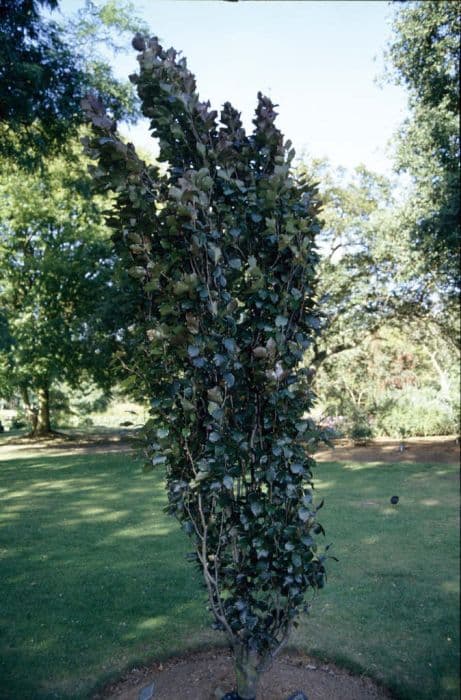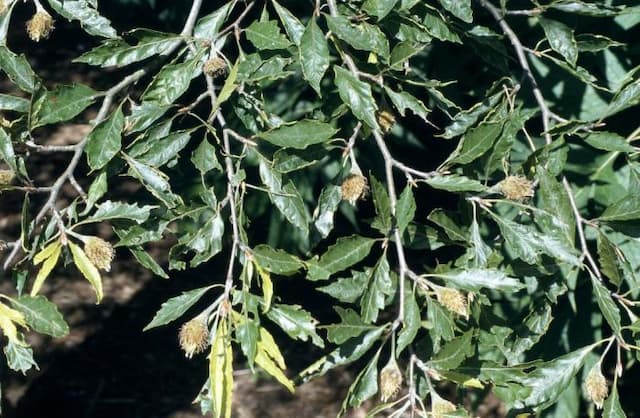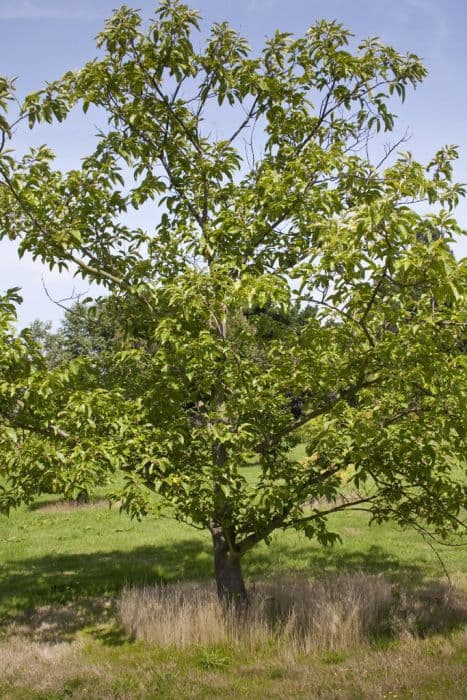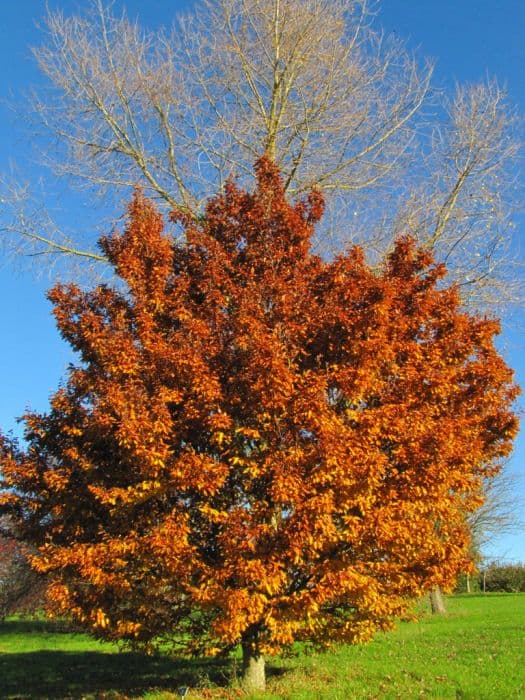European beech Fagus sylvatica (Atropurpurea Group) 'Riversii'

ABOUT
The Riversii Copper Beech is a striking deciduous tree known for its unique foliage and elegant structure. This variety of the Copper Beech features deep purple, almost black leaves that emerge in the spring. These leaves transform the landscape with their vibrant color and then gradually fade to a coppery green as the seasons progress, creating a dynamic display throughout the year. The leaves are oval in shape with wavy edges and a glossy texture, giving the tree a luxurious appearance. In the spring, the foliage is accompanied by small, inconspicuous flowers that are usually not the main attraction, as they are overshadowed by the dramatic foliage. Following the flowers, the tree may produce fruits that are small, spiky capsules containing beechnuts, which are often appreciated by wildlife. The Riversii Copper Beech has a strong and majestic presence, with a sturdy central trunk from which a well-structured network of branches emanates, creating a densely rounded to broad-spreading canopy that provides ample shade beneath. The bark of the tree is smooth and silvery gray, adding to its elegant profile. Overall, the Riversii Copper Beech is celebrated for its alluring leaf color and its ability to create a commanding visual impact in the landscape, making it a favorite among gardeners looking to add a touch of drama and year-round interest to their gardens without focusing on the plant's size.
About this plant
 Names
NamesSynonyms
River's Beech, Purple Beech, Copper Beech, Red Beech.
Common names
Fagus sylvatica f. purpurea, Fagus sylvatica var. atropunicea, Fagus sylvatica 'Atropunicea', Fagus sylvatica f. atropurpurea, Fagus sylvatica 'Riversii', Fagus sylvatica 'Purpurea', Fagus sylvatica 'Atropurpurea'.
 Toxicity
ToxicityTo humans
The European beech is generally not considered highly toxic to humans. However, like many trees, parts of the plant can be harmful if ingested in large quantities. Eating the nuts or leaves might cause gastrointestinal discomfort, including symptoms such as nausea, vomiting, or diarrhea. It's worth noting that the nuts contain small amounts of a toxic compound called fagin or fagine, which can cause headaches, stomach pain, or even potential kidney damage in very large amounts. Always exercise caution and avoid ingesting parts of plants that are not commonly considered edible.
To pets
European beech, including the 'Riversii' variety, is not generally known for being poisonous to pets. However, ingestion of leaves or nuts in significant quantity can potentially lead to gastrointestinal upset, which may manifest as vomiting or diarrhea in pets such as dogs and cats. While serious toxicity is rare, the nuts do contain fagin, which can be mildly toxic and could cause symptoms like abdominal pain or more serious issues in large doses. If your pet consumes a large quantity of any part of the tree, monitoring for any signs of illness and consulting a veterinarian is recommended.
 Characteristics
CharacteristicsLife cycle
Perennials
Foliage type
Deciduous
Color of leaves
Purple
Height
60 feet (18 meters)
Spread
35 feet (10.67 meters)
Plant type
Tree
Hardiness zones
4
Native area
Europe
Benefits
 General Benefits
General Benefits- Attractive Foliage: The plant is known for its rich, purple leaves that provide striking color contrast in landscapes.
- Shade Provider: As a large deciduous tree, it offers ample shade in gardens and parks.
- Habitat Support: 'Riversii' serves as a habitat for various wildlife, offering shelter and food for birds and insects.
- Seasonal Interest: It presents a year-round interest with its spring foliage, summer shade, autumn color transformation, and winter silhouette.
- Durability: This variety of European Beech is robust and can withstand harsh weather conditions, making it a long-lived addition to the landscape.
- Soil Improvement: The leaf litter from 'Riversii' decomposes and enriches the soil, improving its fertility over time.
 Medical Properties
Medical PropertiesThis plant is not used for medical purposes.
 Air-purifying Qualities
Air-purifying QualitiesThis plant is not specifically known for air purifying qualities.
 Other Uses
Other Uses- Copper beech 'Riversii' wood can be used for creating fine furniture due to its durability and attractive grain.
- The dense canopy of the copper beech 'Riversii' makes it suitable for providing privacy screens in gardens and parks.
- Because of its unique appearance, the copper beech 'Riversii' is often used in bonsai cultivation for its aesthetic appeal.
- The leaves of the copper beech 'Riversii' can be used as a natural mulch, contributing to soil fertility as they decompose.
- Woodturners use the wood of copper beech 'Riversii' to craft decorative items like bowls and vases.
- Copper beech 'Riversii' trees can be planted to create windbreaks that protect smaller plants and reduce soil erosion.
- The tree is occasionally used in the art of dendrochronology to study climate changes and historical events due to its longevity and growth rings.
- Its rich-colored foliage is sought after by photographers and artists for capturing the essence of autumn in their work.
- Copper beech 'Riversii' timber is sometimes used in the production of musical instruments for its tonal qualities.
- In landscape architecture, copper beech 'Riversii' is used to create focal points or to enhance the architectural features of buildings.
Interesting Facts
 Feng Shui
Feng ShuiThe European beech is not used in Feng Shui practice.
 Zodiac Sign Compitability
Zodiac Sign CompitabilityThe European beech is not used in astrology practice.
 Plant Symbolism
Plant Symbolism- Endurance and Strength: As a variety of beech tree, Fagus sylvatica 'Riversii', commonly known as the Copper beech or Purple beech, symbolizes endurance and strength, reflecting the hardiness and longevity of the species which can live for several centuries.
- Wisdom and Knowledge: Historically, beech trees have been associated with wisdom and knowledge, partly due to their old age and the traditional use of beech bark for writing in ancient societies, creating a strong literary connection.
- Patience: The slow growth of the beech tree also symbolizes patience, illustrating the idea that time and persistence lead to worthwhile results and the growth of a strong foundation.
- Nobility: The majesty of the Copper beech, with its striking purplish leaves, is often connected to nobility and magnificence. This association makes it a symbol of dignity and grandeur, often used in royal gardens and landscapes.
- Prosperity: Beech trees have also been seen as a symbol of prosperity, where an abundance of beech nuts in the wild was historically an indicator of a good harvest, and therefore of a prosperous year ahead.
 Water
WaterThe common name for Fagus sylvatica (Atropurpurea Group) 'Riversii' is the 'Rivers Purple Beech'. For watering, it's essential to maintain consistent moisture, especially during the first few years after planting to establish a strong root system. Water deeply once a week, providing about 1 to 2 gallons for young trees, and 10 to 15 gallons for larger, established trees. During hot and dry weather, increase the frequency to twice a week. If the beech is planted in an area with heavier soil that retains moisture, watering can be reduced accordingly. It's important to avoid overwatering and ensure the soil has good drainage to prevent root rot.
 Light
LightThe 'Rivers Purple Beech' thrives best in full sun to partial shade. It prefers a location where it can receive at least six hours of direct sunlight daily, but can also tolerate some shade. Avoid placing it in deep shade, as insufficient light can lead to reduced foliage color intensity and poor growth. An ideal spot would be one that receives morning sunlight and partial afternoon shade, providing a balance of light exposure throughout the day.
 Temperature
TemperatureThe 'Rivers Purple Beech' is hardy and can withstand a range of temperatures, ideally thriving in environments where the average temperature is between 60°F and 70°F. It can survive winter temperatures down to about -20°F, making it suitable for many temperate regions. During the growing season, the beech prefers cooler temperatures and may become stressed in areas where temperatures exceed 95°F for extended periods.
 Pruning
PruningPruning the 'Rivers Purple Beech' is mainly done to shape the tree, remove any dead or diseased branches, and to encourage healthy growth. The best time to prune is during the dormant season, in late winter or early spring before new leaves emerge. It's recommended to prune selectively and avoid heavy pruning; typically, once every 3 to 5 years is sufficient for maintenance. Always use sharp, clean tools to make clean cuts and minimize stress to the tree.
 Cleaning
CleaningAs needed
 Soil
SoilThe European beech 'Riversii' requires well-draining, fertile soil with a slightly acidic to neutral pH of around 5.5 to 7.0. A mix of loam, compost, and leaf mold is ideal for providing the necessary nutrients and structure.
 Repotting
RepottingThe European beech 'Riversii' is a large tree and generally not repotted. It's planted in a permanent location where it can grow undisturbed for many years.
 Humidity & Misting
Humidity & MistingEuropean beech 'Riversii' prefers moderate humidity conditions but is adaptable to various outdoor environments without specific humidity requirements.
 Suitable locations
Suitable locationsIndoor
Generally not suited for indoor growth; requires outdoor space.
Outdoor
Plant in well-draining soil, full sun to partial shade, ample space.
Hardiness zone
4-7 USDA
 Life cycle
Life cycleFagus sylvatica 'Riversii', commonly known as the European Beech or Purple Beech, begins its life cycle with seed germination, which typically occurs in spring when soil temperatures rise. The germinated seedlings establish a root system and produce their first leaves, entering the juvenile stage as they grow into saplings. During this stage, which can last several years, the tree gradually matures and increases in height and girth. Once maturity is reached, the tree enters the reproductive phase, characterized by the annual production of flowers and nuts; the flowers are wind-pollinated, and the nuts are often dispersed by wildlife. The mature tree can live for several centuries, maintaining a cycle of flowering and seed production. As it ages, the tree will eventually enter senescence, characterized by a decline in vitality and productivity until it ultimately dies, completing its life cycle.
 Propogation
PropogationPropogation time
Late winter-early spring
The European beech 'Riversii', a variety of Fagus sylvatica known for its purple foliage, is most commonly propagated by grafting. This process involves taking a piece of a stem with leaf buds from a 'Riversii' beech and inserting it into the stock of a common beech root system. Grafting is typically done during the late winter or early spring before new growth starts. The stem piece, or scion, is carefully joined with a rootstock so that the vascular tissues align, allowing the scion to receive water and nutrients from the rootstock. The joint is then taped or waxed to prevent drying and infection. Over time, the tissues of the two parts grow together and form a new tree that carries the characteristics of the 'Riversii' foliage on the rootstock's hardy foundation. Grafting is preferred for preserving the exact traits of the 'Riversii' variety, as seed propagation can result in seedlings that do not retain the parent's desirable purple leaf coloration.









